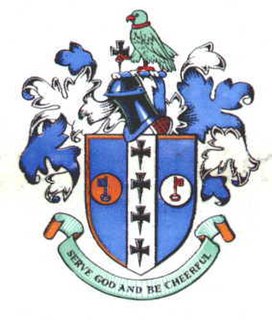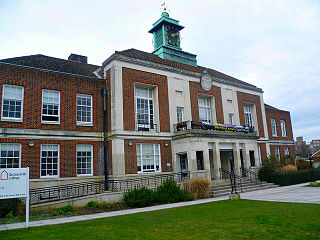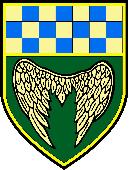
Beddington is a suburban settlement in the London Borough of Sutton on the boundary with the London Borough of Croydon. Beddington is formed from a village of the same name which until early the 20th century still included land which became termed entirely as Wallington. The latter was in the 13th century shown on local maps as Hakebrug, and named after a bridge on the River Wandle. The locality has a landscaped wooded park at Beddington Park – also known as Carew Manor; and a nature reserve and sewage treatment works in the centre and to the north of its area respectively. The population of Beddington according to the 2011 census is 21,044.

Carshalton is a town, with a historic village centre, in south London, England, within the London Borough of Sutton. It is situated 9.5 miles (15.3 km) south-southwest of Charing Cross, in the valley of the River Wandle, one of the sources of which is Carshalton Ponds in the middle of the village. Prior to the creation of Greater London in 1965, Carshalton was in the administrative county of Surrey.

Waddon is a neighbourhood in the London Borough of Croydon, at the western end of the town of Croydon. The area borders the London Borough of Sutton.

Wallington is a town in the London Borough of Sutton, in South London, England. It is 9.7 miles (15.6 km) south south-west of Charing Cross. Before the Municipal Borough of Beddington and Wallington merged into the London Borough of Sutton in Greater London in 1965, it was part of the county of Surrey. Wallington is a post town in the SM postcode area.

The London Borough of Sutton is a London borough in south-west London, England and forms part of Outer London. It covers an area of 43 km2 (17 sq mi) and is the 80th largest local authority in England by population. It borders the London Borough of Croydon to the east, the London Borough of Merton to the north and the Royal Borough of Kingston upon Thames to the north-west; it also borders the Surrey boroughs of Epsom and Ewell and Reigate and Banstead to the west and south respectively. The local authority is Sutton London Borough Council. Its principal town is the eponymous Sutton.

Coulsdon and Purley Urban District was a local government district in northeast Surrey from 1915 to 1965. The local authority was Coulsdon and Purley Urban District Council. The former area of the district is now mostly part of the London Borough of Croydon in Greater London, with parts in the Tandridge District and the Borough of Reigate and Banstead in Surrey.

The A232 is a road running west-east across South London, which connects the A24 in Ewell with the A224 Orpington bypass.

Sutton and Cheam was a local government district in north east Surrey, England from 1882 to 1965.

Beddington and Wallington was, from 1915 to 1965, a local government district in north east Surrey, England. It formed part of the London suburbs, lying within the Metropolitan Police District and the London Passenger Transport Area. In 1965 it was abolished on the creation of Greater London.
Wallington was an ancient hundred in the northeast of the historic county of Surrey, England. The majority of its area has been absorbed by the growth of London; with its name currently referring to the district of Wallington. Its former area now corresponds to the London Borough of Sutton, the majority of the London Borough of Croydon and parts of the London Borough of Merton as well as parts of the Districts of Epsom and Ewell, Reigate and Banstead and Tandridge in Surrey.

Wallington High School for Girls is an all-girls selective grammar school in the London Borough of Sutton, England, specialising in STEM subjects and Languages.
Sir Richard James Meller was a British barrister and Conservative politician.
Woodcote Green is an area in the London Borough of Sutton, located in the south-east of the borough south of Wallington. At the 2011 Census the population of the area was included in the Beddington South ward of Sutton Council.

Croydon Town Hall is a council building in Katherine Street, Croydon which serves as headquarters for Croydon London Borough Council. It is a Grade II listed building.

Lewisham Town Hall is a municipal building in Catford Road, Lewisham, London. The oldest part of the facility, the curved municipal offices, which is the headquarters of Lewisham London Borough Council, is a Grade II listed building.

Mitcham Vestry Hall is a municipal building in London Road, Mitcham, London. It is a locally listed building.

East Barnet Town Hall is a former municipal building in Station Road, East Barnet, London, England. The town hall, which was the headquarters of East Barnet Urban District Council, is a locally listed building.

The Carshalton Council Offices is a former municipal building on The Square, Carshalton, London. The structure, which was briefly the headquarters of Carshalton Urban District Council before becoming a public library, is a Grade II listed building.
















